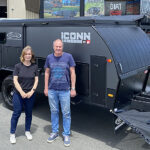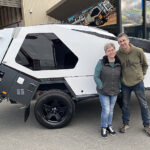
The Pilbara is a large, dry, sparsely populated region in the north of Western Australia, with significant mining interests, in particular, iron ore, crude oil, salt and natural gas. Beyond mining, the area is renowned for a diversity of scenery – the striking ochre-coloured gorges and flat top mesas of Karijini and Millstream vs the magnificent turquoise waters and pristine beaches of the Ningaloo Reef and beyond. Sounds inviting – you bet!
Over the next three editions, join us as we explore the region starting with Cape Range National Park on the north west coast of Western Australia.
Cape Range National Park
The Cape Range National Park is just south of Exmouth, at the northern end of the Ningaloo Reef. As Australia’s largest and most accessible fringing reef, swimming, snorkelling and fishing opportunities abound, abundant with colourful reef fish that swim into the shallows to feed off the reef.


Extending to the coastline, the rugged limestone ranges hint of the landscapes further east, with magnificent deep gorges, canyons, caves and plentiful wildlife. We propped the camper at the Kurrajong campsite after booking online.
The campgrounds restrict camping to around a dozen sites on flat, well maintained plots with drop toilets and gas bbqs in lieu of campfires. Two of the campgrounds, Pilgramunna and Lakeside, are affected by king tides each year, with both camps evacuated; something easily avoided by camping elsewhere.

The tourist season peaks between April and June. Many come to see the whale sharks, the world’s largest fish, which come to the area to feed off krill following the annual coral spawning. Dugongs, green turtles, manta rays, or dolphins also frequent the area. Co-ordinated through Exmouth, tourist operators offer a range of activities from coral viewing, kayaking to the outer reef or swimming with the whale sharks.

There are a number of beaches better suited to swimming, but Turquoise Bay is easily the best, with a big white sandy beach and clear, blue water, ideal for water activities. A unique feature is the Loop Beach – snorkel near the shore, admiring the reef fish as the current carries you out and drops you at the next bay in good conditions. Just check with the Milyering Visitor Centre before you snorkel to ensure the conditions are suitable. Otherwise the Oyster Stacks is a good snorkelling alternative, accessing the water off a rock shelf.

In addition to spectacular beaches, the Cape hosts a number of walks or drives to explore the ranges. Shothole Canyon and Charles Knife Canyon can be accessed from the east, south of Exmouth. Access is via unsealed but well-formed roads, offering spectacular views of the gorges and ridges of the range. On the western side of the ranges, Mandu Mandu Gorge meanders up a dry, rocky creek bed to explore the gorge. Bring good footwear and plenty of water as the creek bed is tricky to navigate in thongs and the dry heartland throws out plenty of heat.
From the south, a walk explores the northern wall of the Yardie Creek gorge. The gorge is the only permanently watered gorge in the park, at around 12m at its deepest point. A boat cruise run by Parks officers educates tourists about the geology, landscape, flora and fauna of the park and is well worth doing. Apart from the impressive coloured gorge walls, bats, rock wallabies and large sea eagle nests are easily spotted along the way.

Access to Cape Range is via sealed roads from the north through Exmouth all the way to Yardie Creek. If you’re travelling from the south and don’t mind a rough road alternative, take the coastal track beyond Ningaloo Station. Apart from the corrugated track, the only real obstacle is crossing Yardie Creek, a tidal crossing, which masks a number of sandy holes. The crossing should only be attempted at low tide after walking it first. According to Parks officers, a few vehicles are marooned in the creek crossing each year, usually with hard tyres, still in two-wheel drive and having driven straight into one of the holes! Enough said.

Well that’s it for the first leg in our Pilbara adventure. Join us again next time, as we discover the jewel in the Pilbara crown, the lesser visited Millstream-Chichester National Park and in particular, a pristine camping area away from the madding crowd. You can read that here.














